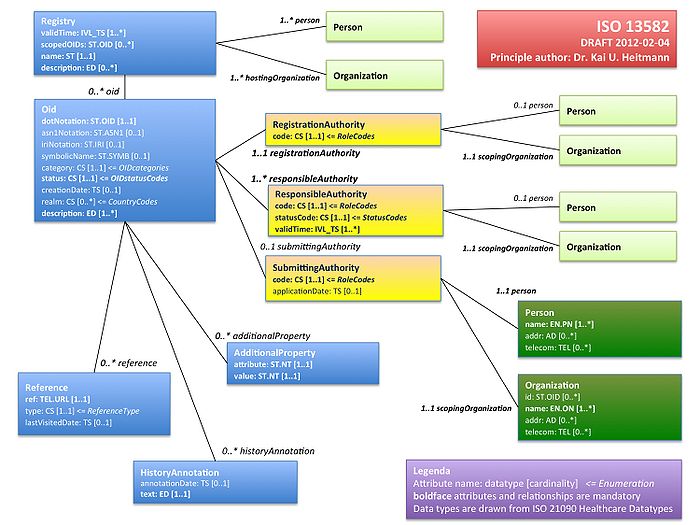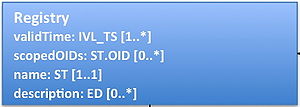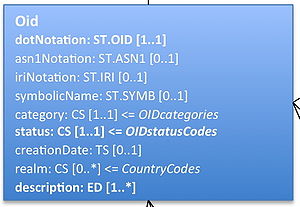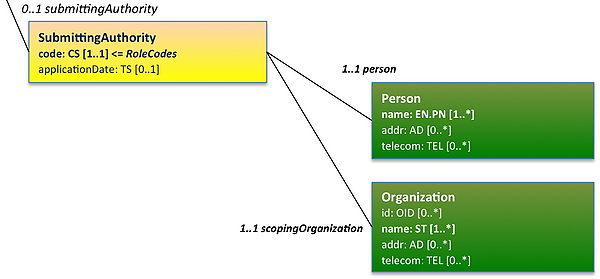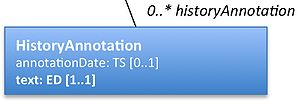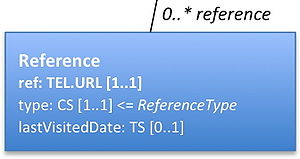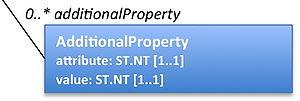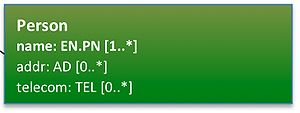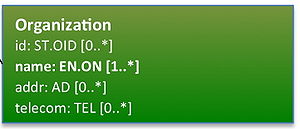ISO13582-part2: Unterschied zwischen den Versionen
(→Entity Name for a organization EN.ON) |
(→category) |
||
| (30 dazwischenliegende Versionen desselben Benutzers werden nicht angezeigt) | |||
| Zeile 1: | Zeile 1: | ||
| − | = | + | =Information model= |
| − | + | In order to exchange OID and their metadata between different registries and applications the following additional data items beyond the OID itself need to be taken under consideration (see also | |
| + | <ref>[http://www.itu.int/rec/T-REC-X.680/en Recommendation ITU-T X.680 (2008) | ISO/IEC 8824-1: 2008, Information Technology – Abstract Syntax Notation One (ASN.1), Specification of Basic Notation, 1997]</ref> | ||
| + | <ref>[http://www.itu.int/rec/T-REC-X.667/en Recommendation ITU-T X.667 | ISO/IEC 9834-8: Information technology – Open Systems Interconnection – Procedures for the operation of OSI Registration Authorities: Generation and registration of Universally Unique Identifiers (UUIDs) and their use as ASN.1 object identifier components]</ref>): | ||
| + | * descriptions | ||
| + | * status information | ||
| + | * categorization | ||
| + | * time information | ||
| + | * comments | ||
| + | * versions | ||
| + | * links | ||
| + | * relationships to other OIDs and external sources | ||
| + | * registering and responsible organizations | ||
| + | * associated persons. | ||
| − | + | An information model with all classes, attributes and their properties aiming on a common understanding of the requirements of an OID registry has been created (Figure 1). | |
| − | + | [[Datei:Oidmodel.jpg|700px|OID Registry Model (Draft)]] | |
| − | + | ==XML exchange format== | |
| − | + | Data exchange can be facilitated by a standardized representation of the complete set of information as an XML structure together with the associated checks of underlying constraints and business rules. This XML structure for importing and exporting OID amongst different registries and other healthcare applications is aiming on the availability of reliable information about OIDs. | |
| − | |||
| − | + | The following sections summarise and explain classes and their attributes. | |
| − | + | ||
| − | + | ==Registry== | |
| − | + | This is the basic information about the OID-Registry hosting the OIDs. | |
| + | |||
| + | [[Datei:Oid-registry.jpg | 300px]] | ||
| − | == | + | ===Attributes=== |
| − | |||
{|class="hl7table" | {|class="hl7table" | ||
| − | ! | + | ! Attribute !! Description !! DT !! Card !! Conf || Length |
| − | |||
| − | |||
|- | |- | ||
| − | | 1 || | + | | validTime || validity time interval || IVL_TS || 1..* || mandatory || - |
|- | |- | ||
| − | | | + | | scopedOIDs || List of scoped root OIDs || ST.OID || 0..* || optional || 64 |
|- | |- | ||
| − | | | + | | name || Official name of the OID registry || ST || 1..1 || mandatory || 64 |
|- | |- | ||
| − | | | + | | description || Description of the OID registry, possible in multiple languages || ED || 0..* || optional || - |
|- | |- | ||
| − | |||
|} | |} | ||
| − | == | + | ====validTime==== |
| − | |||
| + | This is the validity time interval, i.e. the begin (and end) time when this registry is/was responsible for registering OIDs. This can be a list of intervals. | ||
| + | {{ConstraintBox|rg-vt: | ||
| + | A ''validTime'' element shall be present and of datatype IVL_TS with at least the low child element populated. | ||
| + | }} | ||
| + | |||
| + | ====scopedOIDs==== | ||
| + | |||
| + | List of scoped root OIDs, i.e. the OIDs for which this OID registry is responsible for registration. | ||
| + | {{ConstraintBox|rg-so: | ||
| + | If the OID registry is responsible for issuing/registering a root OID, this OID should be listed in ''scopedOIDs''. | ||
| + | }} | ||
| + | |||
| + | ====name==== | ||
| + | |||
| + | Official name of the OID registry | ||
| + | |||
| + | ====description==== | ||
| + | |||
| + | A description of the OID registry, possible in multiple languages | ||
| + | {{ConstraintBox|rg-ds: | ||
| + | If at least one ''description'' element is present one of the description's language code shall be English (“en”, “en-US” etc.). | ||
| + | }} | ||
| + | |||
| + | ===Associations=== | ||
{|class="hl7table" | {|class="hl7table" | ||
| − | ! | + | ! Association !! Description !! Class !! Card !! Conf |
|- | |- | ||
| − | | | + | | person || Contact person(s) || [[#Person|Person]] || 1..* || mandatory |
|- | |- | ||
| − | | | + | | hostingOrganization || Hosting organization || [[#Organization|Organization]] || 1..* || mandatory |
|- | |- | ||
| − | | | + | | oid || List of OIDs || [[#Oid|Oid]] || 0..* || required |
|- | |- | ||
| − | |||
|} | |} | ||
| − | == | + | ===Example=== |
| − | The | + | <syntaxhighlight lang="xml"> |
| + | <registry> | ||
| + | |||
| + | <validTime> | ||
| + | <low value="20100501"/> | ||
| + | </validTime> | ||
| + | |||
| + | <scopedOID value="1.2.3.4.5"/> | ||
| + | |||
| + | <name value="The best OID registry ever"/> | ||
| + | <description language="en-US" value="This is a test OID registry, although the best"/> | ||
| + | |||
| + | <person> ... </person> | ||
| + | <hostingOrganization> ... </hostingOrganization> | ||
| + | |||
| + | <oid> ... </oid> | ||
| + | |||
| + | </registry> | ||
| + | </syntaxhighlight> | ||
| + | |||
| + | ==Oid== | ||
| + | This class contains the registered OID and the associated meta data. | ||
| + | |||
| + | [[Datei:Oid-OID.jpg | 300px]] | ||
| + | |||
| + | ===Attributes=== | ||
{|class="hl7table" | {|class="hl7table" | ||
| − | ! | + | ! Attribute !! Description !! DT !! Card !! Conf || Length |
|- | |- | ||
| − | | | + | | dotNotation || registered OID, dot notation || ST.OID || 1..1 || mandatory || 64 |
|- | |- | ||
| − | | 0 || | + | | asn1Notation || ASN.1 notation || ST.ASN1 || 0..1 || optional || 128 |
|- | |- | ||
| − | | 0 || | + | | iriNotation || IRI notation || ST.IRI || 0..1 || optional || 128 |
|- | |- | ||
| − | | | + | | symbolicName || symbolic name || ST.SYMB || 0..1 || optional || 128 |
| − | | | ||
| − | |||
| − | |||
| − | |||
| − | |||
| − | |||
| − | |||
|- | |- | ||
| − | | | + | | category || OID category || CS || 1..1 || required || - |
|- | |- | ||
| − | | | + | | status || OID status || CS || 1..1 || mandatory || - |
|- | |- | ||
| − | | 0 || | + | | creationDate || date of creation || TS || 0..1 || optional || - |
|- | |- | ||
| − | | | + | | realm || countries || CS || 0..* || optional || - |
| − | | | ||
| − | |||
| − | |||
| − | |||
| − | |||
| − | |||
| − | |||
|- | |- | ||
| − | | | + | | description || textual description || ED || 1..* || mandatory || - |
|- | |- | ||
| − | |||
|} | |} | ||
| − | = | + | ====dotNotation==== |
| − | |||
| − | |||
| − | |||
| − | The | + | The OID in dot notation of SNMP or ASN.1/XER. |
| − | |||
Example: | Example: | ||
<syntaxhighlight lang="xml"> | <syntaxhighlight lang="xml"> | ||
| − | + | 2.16.528 | |
| − | |||
| − | |||
| − | |||
| − | |||
| − | |||
| − | |||
</syntaxhighlight> | </syntaxhighlight> | ||
| − | == | + | ====asn1Notation==== |
| − | + | ||
| + | The OID in ASN.1 notation with (optional) identifiers and numbers. | ||
| − | + | Examples: | |
| − | <syntaxhighlight lang=" | + | <syntaxhighlight lang="text"> |
| − | + | {joint-iso-itu-t(2) country(16) nl(528)} | |
</syntaxhighlight> | </syntaxhighlight> | ||
| − | = | + | <syntaxhighlight lang="text"> |
| − | + | {itu-t(0) recommendation(0) a(1)} | |
| − | {{ | + | </syntaxhighlight> |
| − | + | {{NoteBox| | |
| + | Note that the surrounding curly brackets can be omitted. | ||
}} | }} | ||
| − | {{ | + | {{NoteBox| |
| − | + | Note that this information is not necessarily entered by a human, this item maybe populated algorithmically. | |
}} | }} | ||
| − | + | ====iriNotation==== | |
| − | |||
| − | |||
| − | < | + | The OID in Internationalized Resource Identifier<ref>http://www.oid-info.com/faq.htm#iri</ref> (IRI) notation. |
| − | </ | ||
| − | |||
Example: | Example: | ||
| − | <syntaxhighlight lang=" | + | <syntaxhighlight lang="text"> |
| − | + | oid:/Country/528 | |
| − | |||
| − | |||
| − | |||
| − | |||
</syntaxhighlight> | </syntaxhighlight> | ||
| + | {{NoteBox| | ||
| + | Note that this information is not necessarily entered by a human, this item maybe populated algorithmically. | ||
| + | }} | ||
| − | == | + | ====symbolicName / Secondary Arc Identifier ==== |
| − | |||
| − | |||
| − | |||
| − | |||
| − | |||
| − | |||
| − | |||
| − | + | A symbolic short name, unique among the siblings of the arc of the OID. | |
| − | |||
| − | |||
| − | |||
| − | |||
| − | |||
| − | |||
| − | |||
| − | + | The ISO rules on Secondary Arc Identifiers, as laid out in Rec. ITU-T | ISO/IEC 9834-1 ''Procedures for Registration Authorities'', section 6.2.2, apply: | |
| − | + | * identifiers of an arc are required to commence with a lowercase letter, and to contain only letters, digits, and hyphens. | |
| + | * the last characters shall not be a hyphen | ||
| + | * there shall be no two consecutive hyphens in the name | ||
| − | Example | + | Example |
| − | <syntaxhighlight lang=" | + | <syntaxhighlight lang="text"> |
| − | + | nl | |
</syntaxhighlight> | </syntaxhighlight> | ||
| − | == | + | ====category==== |
| − | |||
| − | + | The type/category of the OID; enumeration, values see value set [[#OIDcategories|OIDcategories]]. | |
| − | |||
| − | |||
| − | |||
| − | + | There are actually two main types of OIDs: ''leafs'' (id of an object), and ''nodes'' representing an ontological branch. | |
| − | |||
| − | The | + | The types of ''node'' OID may be |
| − | + | * a registration authority (RA) or | |
| + | * a structure for the management of OIDs. | ||
| − | + | The proposal for sub categories of ''leaf'' OIDs are | |
| − | + | * identifiers of an instance of an object (for example a person) | |
| − | + | * namespace identifiers (for example code systems, value sets) | |
| − | + | {{NoteBox| | |
| − | {{ | + | In addition there are properties of OIDs that can reflect other business needs. |
| − | + | These can be | |
| + | * tags (simple text) | ||
| + | * other categorizations of the OID, coded or as text | ||
| + | * "sub-types" of the OID | ||
| + | For further information see ''[[#AdditionalProperty|AdditionalProperty]]''. | ||
}} | }} | ||
| − | |||
| − | |||
| − | + | ====status==== | |
| − | + | ||
| − | + | Status of the OID. This is an enumeration, for values see value set [[#OIDstatusCodes|OIDstatusCodes]] | |
| − | The | + | |
| − | + | ====creationDate==== | |
| − | == | + | |
| − | + | The creationDate is used to describe when the OID was first registered. It is not the date when the OID description is submitted to the OID repository. | |
| + | The creationDate, once set, never changes. | ||
| + | |||
| + | ====realm==== | ||
| − | + | In some cases OIDs may apply to a specific county/realm only, e.g. the namespace identifiers for the US Social Security Number (SSN) or the Dutch Citizen Service Number (BSN) or the codes system representing ICD-10 International Classification of Diseases 10th Revision for the use in Germany only (ICD10gm). This can be indicated by ''realm'' which is either the code of country or "UV" for universal. For values see code system [[#CountryCodes| CountryCodes]]. | |
| − | |||
| − | |||
| − | |||
| − | |||
| − | |||
| − | |||
| − | + | ====description==== | |
| − | |||
| − | |||
| − | |||
| − | |||
| − | == | ||
| − | |||
| − | |||
| − | |||
| − | |||
| − | + | This element contains a free text description of the OID ("what is the OID?"). The text typically contains an explanation but also can contain: | |
| − | This | + | * explicit versioning aspects |
| + | * licensing information | ||
| + | * Intellectual Property rights information | ||
| + | * trademarks. | ||
| − | + | This element is repeatable for each language. | |
| − | |||
| − | |||
| − | |||
| − | + | The datatype [[#ED|ED]] allows for a thumbnail child element. A thumbnail may be populated describing a short description of the OID (sometimes referred to as ''identifier name''). | |
| − | |||
Example: | Example: | ||
<syntaxhighlight lang="xml"> | <syntaxhighlight lang="xml"> | ||
| − | < | + | <description language="en-US" value="this is plain text as a long description"> |
| + | <thumbnail value="short text"/> | ||
| + | </description> | ||
</syntaxhighlight> | </syntaxhighlight> | ||
| − | + | {{NoteBox| | |
| − | + | Note that data type [[#ED|ED]] also reflects the aspect of language of the description (language code). | |
| + | }} | ||
| − | + | {{ConstraintBox|oi-ds: | |
| + | There SHALL be one description instance with language code English (“en”, “en-US” etc.). | ||
| + | }} | ||
| − | == | + | ===Associations=== |
| − | + | {|class="hl7table" | |
| + | ! Association !! Description !! Class !! Card !! Conf | ||
| + | |- | ||
| + | | registrationAuthority || Registration Authority || [[#RegistrationAuthority|RegistrationAuthority]] || 1..1 || required | ||
| + | |- | ||
| + | | responsibleAuthority || Responsible Authority || [[#ResponsibleAuthority | ResponsibleAuthority]] || 1..* || required | ||
| + | |- | ||
| + | | submittingAuthority || Submitting Authority || [[#SubmittingAuthority | SubmittingAuthority]] || 0..1 || optional | ||
| + | |- | ||
| + | | additionalProperty || Additional Properties || [[#AdditionalProperty | AdditionalProperty]] || 0..* || optional | ||
| + | |- | ||
| + | | historyAnnotation || History Annotations || [[#HistoryAnnotation | HistoryAnnotation]] || 0..* || optional | ||
| + | |- | ||
| + | | reference || References || [[#Reference | Reference]] || 0..* || optional | ||
| + | |- | ||
| + | |} | ||
| − | + | ==RegistrationAuthority== | |
| − | |||
| − | |||
| − | |||
| − | |||
| − | |||
| − | |||
| − | |||
| − | |||
| − | |||
| − | |||
| − | |||
| − | |||
| − | |||
| − | |||
| − | |||
| − | |||
| − | |||
| − | + | [[Datei:Oid-RegistrationAuthority.jpg | 600px]] | |
| − | |||
| − | |||
| − | |||
| − | |||
| − | |||
| − | |||
| − | |||
| − | |||
| − | |||
| − | |||
| − | |||
| − | |||
| − | |||
| − | + | This class represents the Registration Authority (RA). | |
| − | |||
| − | |||
| − | = | + | ===Attributes=== |
| − | |||
| − | = | + | {|class="hl7table" |
| − | + | ! Attribute !! Description !! DT !! Card !! Conf || Length | |
| + | |- | ||
| + | | code || RA role code || CS || 1..1 || mandatory || - | ||
| + | |- | ||
| + | |} | ||
| − | === | + | ====code==== |
| − | + | The code holds information about the role type of the RA. Valid codes are listed in [[#RoleCodes|RoleCodes]]. | |
| − | |||
| − | === | + | ===Associations=== |
| − | + | {|class="hl7table" | |
| − | + | ! Association !! Description !! Class !! Card !! Conf | |
| + | |- | ||
| + | | scopingOrganization || Scoping organization || [[#Organization|Organization]] || 1..1 || mandatory | ||
| + | |- | ||
| + | | person || Contact person(s) || [[#Person|Person]] || 0..1 || optional | ||
| + | |- | ||
| + | |} | ||
| − | == | + | ==ResponsibleAuthority== |
| − | + | This is a class representing the (managing) authority that is responsible for the object that is identified by the OID (not for the OID itself). | |
| − | |||
| − | |||
| − | |||
| − | |||
| − | + | [[Datei:Oid-ResponsibleAuthority.jpg | 600px]] | |
| − | |||
| − | |||
| − | |||
| − | === | + | ===Attributes=== |
| − | |||
| − | |||
| − | |||
| − | |||
| − | |||
| − | |||
| − | = | + | {|class="hl7table" |
| − | + | ! Attribute !! Description !! DT !! Card !! Conf || Length | |
| − | + | |- | |
| − | + | | code || role code || CS || 1..1 || mandatory || - | |
| − | + | |- | |
| − | + | | statusCode || status code || CS || 1..1 || mandatory || - | |
| − | + | |- | |
| − | * | + | | validTime || validity time || IVL_TS || 1..* || mandatory || - |
| − | + | |- | |
| − | + | |} | |
| − | == | + | ====code==== |
| − | + | The code holds information about the role type of the ResponsibleAuthority. Valid codes are listed in [[#RoleCodes|RoleCodes]]. | |
| − | |||
| − | |||
| − | + | ====statusCode==== | |
| − | + | The statusCode holds information about the status of the ResponsibleAuthority. Valid codes are listed in [[#RoleStatus|RoleStatus]]. | |
| − | |||
| − | == | + | ====validTime==== |
| + | This is an interval of time, representing the period when the ResponsibleAuthority is/was responsible for the object that is identified by the OID. If the ResponsibleAuthority is still responsible, only ''validTime.low'' is populated. | ||
| − | + | ===Associations=== | |
| + | {|class="hl7table" | ||
| + | ! Association !! Description !! Class !! Card !! Conf | ||
| + | |- | ||
| + | | scopingOrganization || Scoping organization || [[#Organization|Organization]] || 1..1 || mandatory | ||
| + | |- | ||
| + | | person || Contact person(s) || [[#Person|Person]] || 0..1 || optional | ||
| + | |- | ||
| + | |} | ||
| − | + | ==SubmittingAuthority== | |
| − | + | This is a class representing the submitting authority that originally asked for a new OID. | |
| − | |||
| − | |||
| − | + | [[Datei:Oid-SubmittingAuthority.jpg | 600px]] | |
| − | + | (Please note: to avoid redundancy, the classes ''Organization'' and ''Peron'' are shown with attributes here, at all other places only a "shadow" class of these two classes is shown) | |
| − | {|class=" | + | ===Attributes=== |
| − | ! | + | {|class="hl7table" |
| − | ! Description | + | ! Attribute !! Description !! DT !! Card !! Conf || Length |
| − | + | |- | |
| + | | code || role code || CS || 1..1 || mandatory || - | ||
| + | |- | ||
| + | | applicationDate || date of application || TS || 0..1 || optional || - | ||
|- | |- | ||
| − | | | + | |} |
| − | + | ||
| − | | | + | ====code==== |
| − | + | The code holds information about the role type of the submitting authority. Valid codes are listed in [[#RoleCodes|RoleCodes]]. | |
| − | + | ====applicationDate==== | |
| − | + | Date of application (submission or certified submission) of the requested OID. | |
| + | |||
| + | ===Associations=== | ||
| + | {|class="hl7table" | ||
| + | ! Association !! Description !! Class !! Card !! Conf | ||
| + | |- | ||
| + | | scopingOrganization || Scoping organization || [[#Organization|Organization]] || 1..1 || mandatory | ||
| + | |- | ||
| + | | person || Contact person(s) || [[#Person|Person]] || 1..1 || mandatory | ||
|- | |- | ||
| − | | | + | |} |
| − | |||
| − | |||
| − | + | ==HistoryAnnotation== | |
| + | This class reflects historical annotations of the OID and records the changes of any data over time. | ||
| − | + | [[Datei:Oid-HistoryAnnotation.jpg | 300px]] | |
| − | + | ===Attributes=== | |
| + | {|class="hl7table" | ||
| + | ! Attribute !! Description !! Datatype !! Cardinality !! Conformance || Recommended Length | ||
| + | |- | ||
| + | | annotationDate || date annotation was created || TS || 0..1 || required || - | ||
| + | |- | ||
| + | | text || annotation || ED || 1..1 || mandatory || - | ||
| + | |- | ||
| + | |} | ||
| + | {{NoteBox| | ||
| + | Note that data type ED also reflects the aspect of language of the description (language code). | ||
| + | }} | ||
| − | + | ==Reference== | |
| − | + | [[Datei:Oid-Reference.jpg | 300px]] | |
| + | |||
| + | This class provides a link to | ||
| + | * other data sources, code tables, value sets, descriptions etc; typically this is a URL and always points to an object with different semantics than the OID itself. | ||
| + | * other OIDs (within or outside this OID registry) in order to be able to express that an OID has been superseded/replaced or that there is a preferred OID. | ||
| + | |||
| + | ===Attributes=== | ||
| + | {|class="hl7table" | ||
| + | ! Attribute !! Description !! DT !! Card !! Conf || Length | ||
|- | |- | ||
| + | | ref || reference URI || URI || 1..1 || mandatory || - | ||
|- | |- | ||
| − | | | + | | type || type of reference || CS || 1..1 || mandatory || - |
| − | | | + | |- |
| − | | | + | | lastVisitedDate || date URI last visited || TS || 0..1 || optional || - |
| − | + | |- | |
| + | |} | ||
| + | |||
| + | ====ref==== | ||
| + | The referenced URI. | ||
| − | + | ====type==== | |
| + | The nature of the reference is coded in the ''type'' attribute, for vocabulary see [[#ReferenceType|ReferenceType]]. | ||
| − | + | ====lastVisitedDate==== | |
| − | + | Specifies the date the UIR was last visited. | |
| − | |||
| − | |||
| − | |||
| − | + | ==AdditionalProperty== | |
| − | + | [[Datei:Oid-AdditionalProperty.jpg | 300px]] | |
| − | + | This class reflects additional properties of an OID that might be used to fit business rules that cannot (or should not) be standardized. This includes: | |
| + | * additional categories | ||
| + | * additional status information | ||
| + | * tags, simple text | ||
| + | * coded properties | ||
| − | + | It is made of | |
| + | * attribute, describing the type of the additional property | ||
| + | * value, the value of the additional property. | ||
| − | + | {|class="hl7table" | |
| + | ! Attribute !! Description !! DT !! Card !! Conf || Length | ||
|- | |- | ||
| − | | | + | | attribute || Additional property type || ST.NT || 1..1 || mandatory || - |
| − | | | ||
| − | | | ||
| − | |||
|- | |- | ||
| − | | | + | | value || Additional property value || ST.NT || 1..1 || mandatory || - |
| − | | | + | |- |
| − | + | |} | |
| + | |||
| + | ==Person== | ||
| + | A class to hold the properties of a person. | ||
| + | |||
| + | [[Datei:Oid-Person.jpg | 300px]] | ||
| − | + | ===Attributes=== | |
| + | {|class="hl7table" | ||
| + | ! Attribute !! Description !! DT !! Card !! Conf || Length | ||
| + | |- | ||
| + | | name || person's name || EN.PN || 1..* || mandatory || - | ||
| + | |- | ||
| + | | addr || person's address || AD || 0..* || optional || - | ||
| + | |- | ||
| + | | telecom || person's telecommunication contact || TEL || 0..* || optional || - | ||
|- | |- | ||
|} | |} | ||
| − | = | + | ==Organization== |
| − | + | A class to hold the properties of an organization. | |
| + | |||
| + | [[Datei:Oid-Organization.jpg | 300px]] | ||
| + | |||
| + | ===Attributes=== | ||
| + | {|class="hl7table" | ||
| + | ! Attribute !! Description !! DT !! Card !! Conf || Length | ||
| + | |- | ||
| + | | id || id (OID) of the organization || ST.OID || 0..* || optional || - | ||
| + | |- | ||
| + | | name || name of the organization || EN.ON || 1..* || mandatory || - | ||
| + | |- | ||
| + | | addr || address of the organization || AD || 0..* || optional || - | ||
| + | |- | ||
| + | | telecom || telecommunication contact of the organization || TEL || 0..* || optional || - | ||
| + | |- | ||
| + | |} | ||
Aktuelle Version vom 3. März 2012, 17:13 Uhr
Inhaltsverzeichnis
Information model
In order to exchange OID and their metadata between different registries and applications the following additional data items beyond the OID itself need to be taken under consideration (see also [1] [2]):
- descriptions
- status information
- categorization
- time information
- comments
- versions
- links
- relationships to other OIDs and external sources
- registering and responsible organizations
- associated persons.
An information model with all classes, attributes and their properties aiming on a common understanding of the requirements of an OID registry has been created (Figure 1).
XML exchange format
Data exchange can be facilitated by a standardized representation of the complete set of information as an XML structure together with the associated checks of underlying constraints and business rules. This XML structure for importing and exporting OID amongst different registries and other healthcare applications is aiming on the availability of reliable information about OIDs.
The following sections summarise and explain classes and their attributes.
Registry
This is the basic information about the OID-Registry hosting the OIDs.
Attributes
| Attribute | Description | DT | Card | Conf | Length |
|---|---|---|---|---|---|
| validTime | validity time interval | IVL_TS | 1..* | mandatory | - |
| scopedOIDs | List of scoped root OIDs | ST.OID | 0..* | optional | 64 |
| name | Official name of the OID registry | ST | 1..1 | mandatory | 64 |
| description | Description of the OID registry, possible in multiple languages | ED | 0..* | optional | - |
validTime
This is the validity time interval, i.e. the begin (and end) time when this registry is/was responsible for registering OIDs. This can be a list of intervals.
|
|
rg-vt: A validTime element shall be present and of datatype IVL_TS with at least the low child element populated. |
scopedOIDs
List of scoped root OIDs, i.e. the OIDs for which this OID registry is responsible for registration.
|
|
rg-so: If the OID registry is responsible for issuing/registering a root OID, this OID should be listed in scopedOIDs. |
name
Official name of the OID registry
description
A description of the OID registry, possible in multiple languages
|
|
rg-ds: If at least one description element is present one of the description's language code shall be English (“en”, “en-US” etc.). |
Associations
| Association | Description | Class | Card | Conf |
|---|---|---|---|---|
| person | Contact person(s) | Person | 1..* | mandatory |
| hostingOrganization | Hosting organization | Organization | 1..* | mandatory |
| oid | List of OIDs | Oid | 0..* | required |
Example
<registry>
<validTime>
<low value="20100501"/>
</validTime>
<scopedOID value="1.2.3.4.5"/>
<name value="The best OID registry ever"/>
<description language="en-US" value="This is a test OID registry, although the best"/>
<person> ... </person>
<hostingOrganization> ... </hostingOrganization>
<oid> ... </oid>
</registry>
Oid
This class contains the registered OID and the associated meta data.
Attributes
| Attribute | Description | DT | Card | Conf | Length |
|---|---|---|---|---|---|
| dotNotation | registered OID, dot notation | ST.OID | 1..1 | mandatory | 64 |
| asn1Notation | ASN.1 notation | ST.ASN1 | 0..1 | optional | 128 |
| iriNotation | IRI notation | ST.IRI | 0..1 | optional | 128 |
| symbolicName | symbolic name | ST.SYMB | 0..1 | optional | 128 |
| category | OID category | CS | 1..1 | required | - |
| status | OID status | CS | 1..1 | mandatory | - |
| creationDate | date of creation | TS | 0..1 | optional | - |
| realm | countries | CS | 0..* | optional | - |
| description | textual description | ED | 1..* | mandatory | - |
dotNotation
The OID in dot notation of SNMP or ASN.1/XER.
Example:
2.16.528
asn1Notation
The OID in ASN.1 notation with (optional) identifiers and numbers.
Examples:
{joint-iso-itu-t(2) country(16) nl(528)}
{itu-t(0) recommendation(0) a(1)}
|
|
Note that the surrounding curly brackets can be omitted. |
|
|
Note that this information is not necessarily entered by a human, this item maybe populated algorithmically. |
iriNotation
The OID in Internationalized Resource Identifier[3] (IRI) notation.
Example:
oid:/Country/528
|
|
Note that this information is not necessarily entered by a human, this item maybe populated algorithmically. |
symbolicName / Secondary Arc Identifier
A symbolic short name, unique among the siblings of the arc of the OID.
The ISO rules on Secondary Arc Identifiers, as laid out in Rec. ITU-T | ISO/IEC 9834-1 Procedures for Registration Authorities, section 6.2.2, apply:
- identifiers of an arc are required to commence with a lowercase letter, and to contain only letters, digits, and hyphens.
- the last characters shall not be a hyphen
- there shall be no two consecutive hyphens in the name
Example
nl
category
The type/category of the OID; enumeration, values see value set OIDcategories.
There are actually two main types of OIDs: leafs (id of an object), and nodes representing an ontological branch.
The types of node OID may be
- a registration authority (RA) or
- a structure for the management of OIDs.
The proposal for sub categories of leaf OIDs are
- identifiers of an instance of an object (for example a person)
- namespace identifiers (for example code systems, value sets)
|
|
In addition there are properties of OIDs that can reflect other business needs.
These can be
|
status
Status of the OID. This is an enumeration, for values see value set OIDstatusCodes
creationDate
The creationDate is used to describe when the OID was first registered. It is not the date when the OID description is submitted to the OID repository. The creationDate, once set, never changes.
realm
In some cases OIDs may apply to a specific county/realm only, e.g. the namespace identifiers for the US Social Security Number (SSN) or the Dutch Citizen Service Number (BSN) or the codes system representing ICD-10 International Classification of Diseases 10th Revision for the use in Germany only (ICD10gm). This can be indicated by realm which is either the code of country or "UV" for universal. For values see code system CountryCodes.
description
This element contains a free text description of the OID ("what is the OID?"). The text typically contains an explanation but also can contain:
- explicit versioning aspects
- licensing information
- Intellectual Property rights information
- trademarks.
This element is repeatable for each language.
The datatype ED allows for a thumbnail child element. A thumbnail may be populated describing a short description of the OID (sometimes referred to as identifier name).
Example:
<description language="en-US" value="this is plain text as a long description">
<thumbnail value="short text"/>
</description>
|
|
Note that data type ED also reflects the aspect of language of the description (language code). |
|
|
oi-ds: There SHALL be one description instance with language code English (“en”, “en-US” etc.). |
Associations
| Association | Description | Class | Card | Conf |
|---|---|---|---|---|
| registrationAuthority | Registration Authority | RegistrationAuthority | 1..1 | required |
| responsibleAuthority | Responsible Authority | ResponsibleAuthority | 1..* | required |
| submittingAuthority | Submitting Authority | SubmittingAuthority | 0..1 | optional |
| additionalProperty | Additional Properties | AdditionalProperty | 0..* | optional |
| historyAnnotation | History Annotations | HistoryAnnotation | 0..* | optional |
| reference | References | Reference | 0..* | optional |
RegistrationAuthority
This class represents the Registration Authority (RA).
Attributes
| Attribute | Description | DT | Card | Conf | Length |
|---|---|---|---|---|---|
| code | RA role code | CS | 1..1 | mandatory | - |
code
The code holds information about the role type of the RA. Valid codes are listed in RoleCodes.
Associations
| Association | Description | Class | Card | Conf |
|---|---|---|---|---|
| scopingOrganization | Scoping organization | Organization | 1..1 | mandatory |
| person | Contact person(s) | Person | 0..1 | optional |
ResponsibleAuthority
This is a class representing the (managing) authority that is responsible for the object that is identified by the OID (not for the OID itself).
Attributes
| Attribute | Description | DT | Card | Conf | Length |
|---|---|---|---|---|---|
| code | role code | CS | 1..1 | mandatory | - |
| statusCode | status code | CS | 1..1 | mandatory | - |
| validTime | validity time | IVL_TS | 1..* | mandatory | - |
code
The code holds information about the role type of the ResponsibleAuthority. Valid codes are listed in RoleCodes.
statusCode
The statusCode holds information about the status of the ResponsibleAuthority. Valid codes are listed in RoleStatus.
validTime
This is an interval of time, representing the period when the ResponsibleAuthority is/was responsible for the object that is identified by the OID. If the ResponsibleAuthority is still responsible, only validTime.low is populated.
Associations
| Association | Description | Class | Card | Conf |
|---|---|---|---|---|
| scopingOrganization | Scoping organization | Organization | 1..1 | mandatory |
| person | Contact person(s) | Person | 0..1 | optional |
SubmittingAuthority
This is a class representing the submitting authority that originally asked for a new OID.
(Please note: to avoid redundancy, the classes Organization and Peron are shown with attributes here, at all other places only a "shadow" class of these two classes is shown)
Attributes
| Attribute | Description | DT | Card | Conf | Length |
|---|---|---|---|---|---|
| code | role code | CS | 1..1 | mandatory | - |
| applicationDate | date of application | TS | 0..1 | optional | - |
code
The code holds information about the role type of the submitting authority. Valid codes are listed in RoleCodes.
applicationDate
Date of application (submission or certified submission) of the requested OID.
Associations
| Association | Description | Class | Card | Conf |
|---|---|---|---|---|
| scopingOrganization | Scoping organization | Organization | 1..1 | mandatory |
| person | Contact person(s) | Person | 1..1 | mandatory |
HistoryAnnotation
This class reflects historical annotations of the OID and records the changes of any data over time.
Attributes
| Attribute | Description | Datatype | Cardinality | Conformance | Recommended Length |
|---|---|---|---|---|---|
| annotationDate | date annotation was created | TS | 0..1 | required | - |
| text | annotation | ED | 1..1 | mandatory | - |
|
|
Note that data type ED also reflects the aspect of language of the description (language code). |
Reference
This class provides a link to
- other data sources, code tables, value sets, descriptions etc; typically this is a URL and always points to an object with different semantics than the OID itself.
- other OIDs (within or outside this OID registry) in order to be able to express that an OID has been superseded/replaced or that there is a preferred OID.
Attributes
| Attribute | Description | DT | Card | Conf | Length |
|---|---|---|---|---|---|
| ref | reference URI | URI | 1..1 | mandatory | - |
| type | type of reference | CS | 1..1 | mandatory | - |
| lastVisitedDate | date URI last visited | TS | 0..1 | optional | - |
ref
The referenced URI.
type
The nature of the reference is coded in the type attribute, for vocabulary see ReferenceType.
lastVisitedDate
Specifies the date the UIR was last visited.
AdditionalProperty
This class reflects additional properties of an OID that might be used to fit business rules that cannot (or should not) be standardized. This includes:
- additional categories
- additional status information
- tags, simple text
- coded properties
It is made of
- attribute, describing the type of the additional property
- value, the value of the additional property.
| Attribute | Description | DT | Card | Conf | Length |
|---|---|---|---|---|---|
| attribute | Additional property type | ST.NT | 1..1 | mandatory | - |
| value | Additional property value | ST.NT | 1..1 | mandatory | - |
Person
A class to hold the properties of a person.
Attributes
| Attribute | Description | DT | Card | Conf | Length |
|---|---|---|---|---|---|
| name | person's name | EN.PN | 1..* | mandatory | - |
| addr | person's address | AD | 0..* | optional | - |
| telecom | person's telecommunication contact | TEL | 0..* | optional | - |
Organization
A class to hold the properties of an organization.
Attributes
| Attribute | Description | DT | Card | Conf | Length |
|---|---|---|---|---|---|
| id | id (OID) of the organization | ST.OID | 0..* | optional | - |
| name | name of the organization | EN.ON | 1..* | mandatory | - |
| addr | address of the organization | AD | 0..* | optional | - |
| telecom | telecommunication contact of the organization | TEL | 0..* | optional | - |
- ↑ Recommendation ITU-T X.680 (2008) | ISO/IEC 8824-1: 2008, Information Technology – Abstract Syntax Notation One (ASN.1), Specification of Basic Notation, 1997
- ↑ Recommendation ITU-T X.667 | ISO/IEC 9834-8: Information technology – Open Systems Interconnection – Procedures for the operation of OSI Registration Authorities: Generation and registration of Universally Unique Identifiers (UUIDs) and their use as ASN.1 object identifier components
- ↑ http://www.oid-info.com/faq.htm#iri
